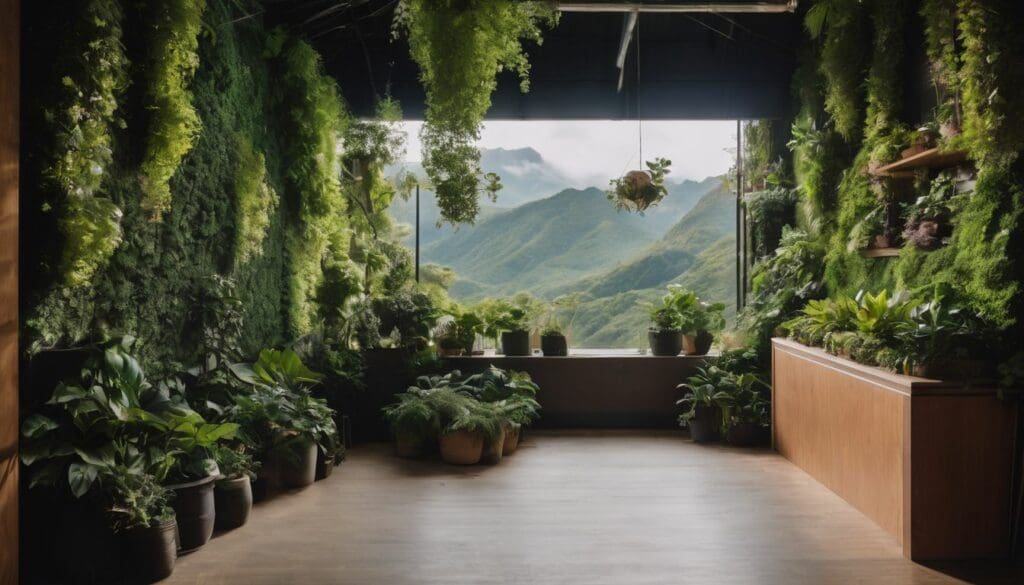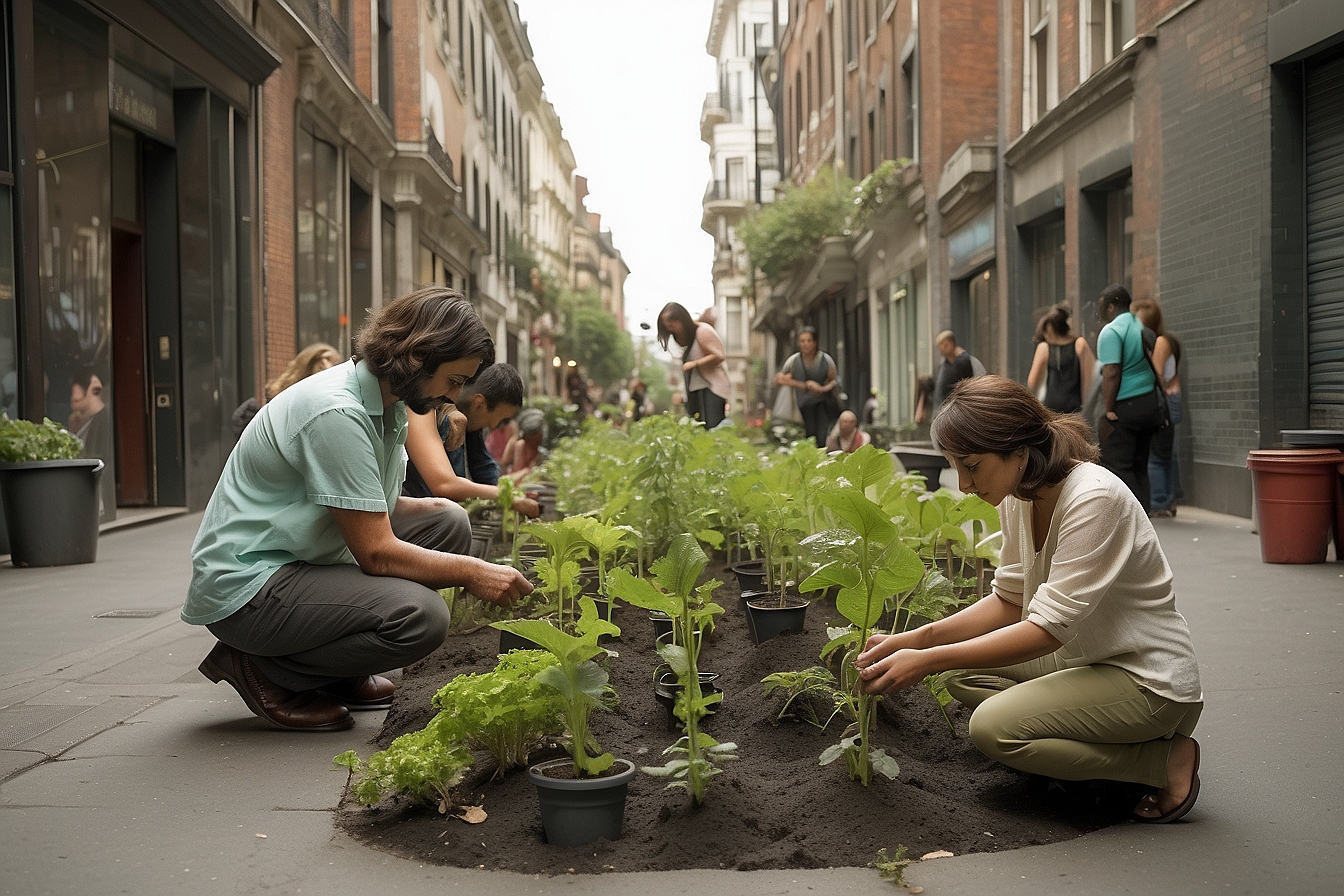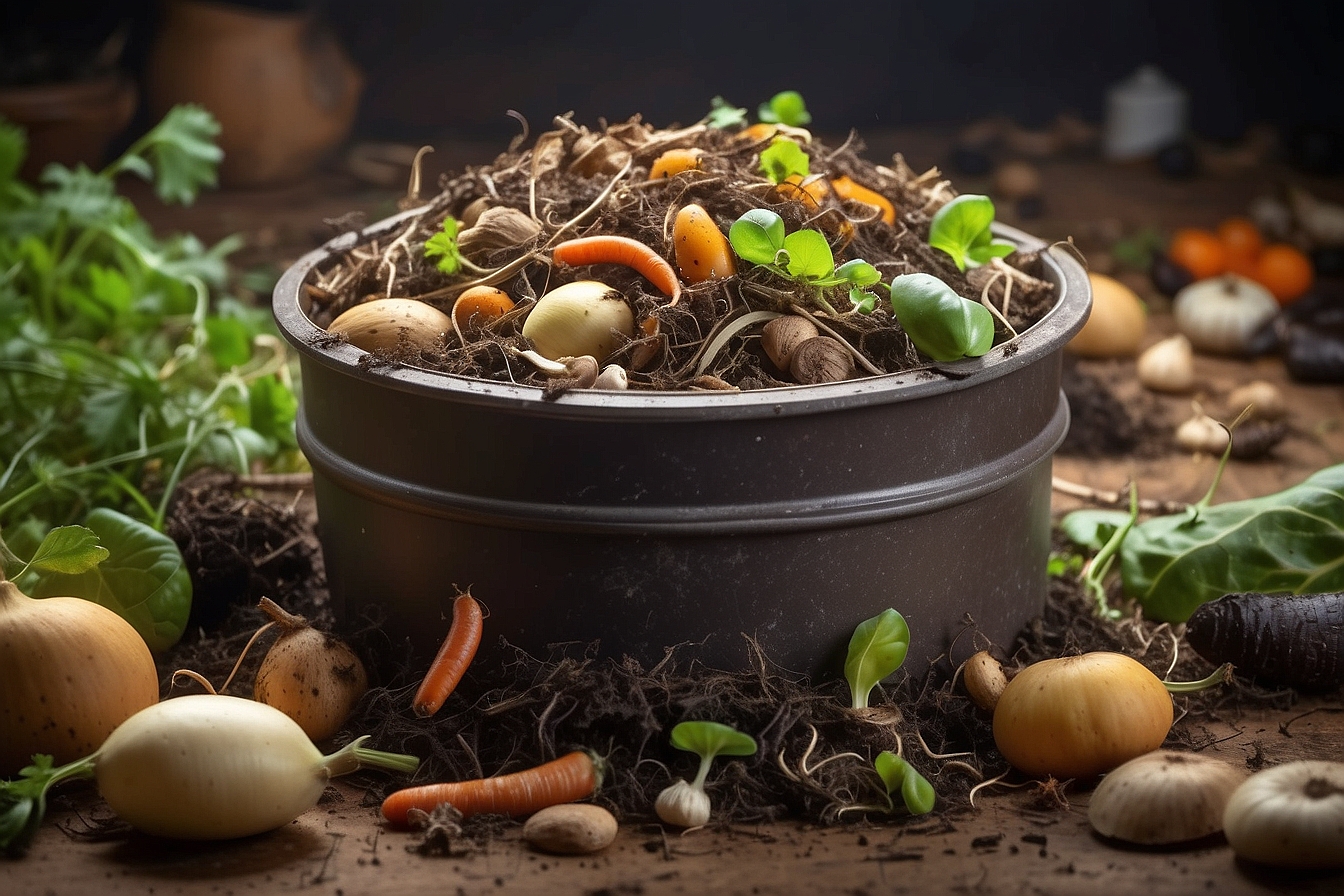Understanding the struggle of trying to squeeze a bit of nature into your life when space is at a premium can be quite the conundrum. Thankfully, we’ve done our homework and it turns out an impressive 93% of city dwellers could really put vertical gardening to good use.
In this guide, you’ll find clever tricks and tips perfect for creating your own vibrant vertical garden in even the snuggest of spaces. So roll up your sleeves—it’s time to embark on a journey where your green-fingered ambitions will reach new heights!
Key Takeaways
- Vertical gardens are an innovative way to bring greenery into compact spaces without sacrificing floor space, ideal for city dwellers with limited outdoor areas.
- They offer multiple benefits including improved air quality, pest reduction, noise dampening and enhanced privacy, while facilitating easier maintenance and resource conservation.
- Various methods such as trellises, stackable planters, terraced beds and hanging containers enable the cultivation of fruits, vegetables, herbs and flowers even in non-traditional spaces like walls or balconies.
- For successful vertical gardening it’s vital to pick the right location with sufficient sunlight. Implementing efficient watering systems along with regular care ensures a healthy garden growth.
- Upcycling items for garden structures is both environmentally friendly and cost-effective; alternatively ready-made solutions simplify setup for instant greening of small spaces.
Benefits of Vertical Gardens for Small Spaces
Vertical gardens are a space-saving solution, providing improved accessibility and visual appeal. They also promote better air flow, prevent pests, reduce noise, and offer easier maintenance while conserving resources.
Space-saving solution
We understand that not everyone has the luxury of a vast garden space. That’s why vertical gardens are such a game-changer for small space gardening. By taking advantage of vertical surfaces like walls, balconies, and fences, we can create lush greenery without eating into precious floor area.
Incorporating hanging containers, trellises, and garden towers allows us to transform even the tiniest balcony or deck into a thriving green oasis. These innovative gardening techniques foster sustainable living by enabling urban agriculture in compact areas.
It’s about growing up, not out – making every inch count in our mission for greener living spaces.
Improved accessibility
Vertical gardens offer improved accessibility for individuals with limited space, making it easier to tend to plants at a comfortable level. No more bending or crouching, as the elevated design allows for convenient care and maintenance of your greenery.
This accessibility also extends to those with physical limitations, enabling them to participate in gardening activities without the need for excessive stooping or kneeling. Moreover, vertical gardens can be positioned at eye-level or within arm’s reach, ensuring that tending to your garden is both effortless and enjoyable.
With enhanced accessibility in mind, let’s explore the various options available when creating a vertical garden in small spaces.
Visual appeal
Vertical gardens add an aesthetic touch to small spaces, creating a lush and vibrant environment. The cascading foliage and colorful blooms enhance the visual appeal of balconies, walls, and other unused vertical surfaces.
Greenery not only beautifies the surroundings but also contributes to a sense of tranquillity and well-being. With carefully selected plant species and thoughtful arrangement, vertical gardens can transform dull areas into captivating displays of nature’s beauty.
Savvy gardeners are finding innovative ways to incorporate greenery into their living spaces with vertical gardens that not only look stunning but also serve as efficient space-saving solutions.
Better air flow
Enhancing air flow in vertical gardens is crucial for plant health and overall garden functionality. Adequate air circulation helps in preventing the build-up of excess moisture, minimising the risk of fungal diseases while ensuring that plants receive the essential carbon dioxide they need for photosynthesis.
By positioning plants vertically, there’s increased exposure to fresh air and sunlight, optimising their growth potential. Proper spacing between plants also contributes to improved ventilation, allowing for better airflow and reducing the likelihood of pests and diseases taking hold within your small space gardening oasis.
For an effective vertical gardening system, it’s important to consider how air flows around your chosen plants or crops. Creating a well-ventilated environment not only benefits the greenery but also promotes a healthier living space overall, making it easier to breathe deeply and enjoy your natural surroundings.
Pest prevention
Pest prevention is crucial in small vertical gardens. We use natural pest control methods, like companion planting and beneficial insect attraction, to protect our plants from pests.
Creating a healthy ecosystem reduces the need for harmful chemical pesticides, keeping our environment clean and safe.
We build physical barriers like netting or row covers to block insects from accessing our plants. Regularly inspecting and maintaining plant health helps us catch any issues early and prevent infestations.
Noise reduction and privacy
Vertical gardens act as a natural sound barrier, helping to reduce unwanted noise from neighbouring spaces and bustling streets. With lush vegetation on vertical surfaces, the plants absorb and deflect sounds effectively, creating a quieter and more peaceful environment for your small space.
Whether indoors or outdoors, vertical gardens offer privacy by providing a green shield that shields you from prying eyes while adding a touch of tranquillity to your surroundings.
In addition to the many advantages of vertical gardens for small spaces, the peace and quiet they provide make them even more appealing. By incorporating these green walls into our living areas, we can enjoy less intrusive noise pollution and greater privacy – essential elements in urban environments where space is limited.
Easier maintenance
With the right design and plant selection, maintaining a vertical garden is relatively straightforward. We can incorporate self-watering systems or drip irrigation to help regulate moisture levels, reducing the need for constant watering.
Additionally, using compost and organic mulch can provide nutrients to plants while minimising weed growth, making maintenance more manageable.
Implementing a mix of low-maintenance plants such as succulents and drought-resistant varieties can also reduce the time and effort required for upkeep. These measures ensure that our vertical garden remains healthy and vibrant with minimal intervention, aligning with our conservation efforts in urban gardening spaces.
Conserved resources
Vertical gardens conserve resources by maximising the use of water and nutrients. The vertical structure minimises water runoff, allowing plants to absorb more moisture and reducing overall water consumption.
This makes them an eco-friendly option for individuals looking to conserve water in their gardening practices. Additionally, the organic matter used in vertical gardens can be recycled back into the soil, promoting sustainability and reducing waste.
Furthermore, vertical gardens also make efficient use of space, enabling individuals to grow more produce in a smaller area. This not only maximises the productivity of a small space but also reduces the need for additional land clearance and deforestation that often occurs with traditional farming practices.
Different Options for Vertical Gardens in Small Spaces
From trellises and arbours to stackable planters and hanging containers, there are numerous creative options for maximising small spaces with vertical gardens. Non-traditional spaces like walls and fences can also be utilised to create stunning greenery.
Trellises and arbors
Trellises and arbours are great options for vertical gardening in small spaces. They provide sturdy support for climbing plants, allowing you to maximise your growing area without taking up valuable ground space.
By using trellises and arbours, you can grow a variety of vining vegetables like tomatoes, cucumbers, and beans, as well as beautiful flowering vines such as jasmine or clematis. These structures also add an aesthetic element to your garden, creating a visually appealing vertical display that enhances the overall look of your outdoor or indoor space.
When using trellises and arbours in your vertical garden, make sure to choose durable materials such as weather-resistant wood or metal that can withstand the elements. Position them strategically to optimise sunlight exposure for your plants while complementing the design of your small space.
Stackable planters
Another option for creating vertical gardens in small spaces is using stackable planters. These are an excellent choice for those who want to maximise their space but still have the flexibility to move their garden if needed.
Stackable planters come in various sizes and designs, allowing you to grow a variety of plants, from herbs and flowers to vegetables. The stacked design provides a visually appealing way to add greenery to your small space without taking up much room, making it an ideal solution for urban environments or compact outdoor areas.
Stackable planters also offer improved accessibility, as they can be easily arranged at different heights, making it easier to reach and care for your plants. This approach not only maximises the use of vertical space but also makes it convenient for harvesting produce and performing maintenance tasks.
Terraced beds
Terraced beds offer a strategic way to optimise vertical gardening in small spaces. By creating multiple levels within the garden, it maximises planting areas while minimising the overall footprint.
This allows for an abundance of plants and vegetation without taking up excessive ground space. The tiered structure also helps to prevent soil erosion and offers efficient drainage, promoting healthy plant growth.
Additionally, terraced beds provide an opportunity to diversify plant types based on their light and water requirements, making it easier to maintain a lush and thriving garden.
The use of terraced beds can further support conservation efforts by utilising vertical space efficiently, offering a sustainable gardening solution for those with limited outdoor areas.
Hanging containers
When considering vertical gardening in small spaces, hanging containers provide an excellent option for maximising space and creating visual interest. These containers can be easily mounted on walls or suspended from ceilings, making them ideal for balconies, terraces, or even indoor areas.
Using stackable planters or pots with built-in hangers allows for a variety of plants to thrive in a compact environment. It also enables gardeners to grow herbs, flowers, and some vegetables without sacrificing valuable floor space.
By utilising hanging containers as part of your vertical garden design, you can elevate the greenery while maintaining accessibility and improving air flow.
Non-traditional spaces
When considering vertical gardens in small spaces, it’s essential to think beyond the conventional options. Non-traditional spaces like fence walls, old ladders, and even recycled wooden pallets provide unique opportunities for creating vertical plant displays.
These innovative spots not only add greenery but also offer a chance to repurpose unused items in an eco-friendly manner. Additionally, utilising non-traditional spaces allows for flexibility and creativity in designing your vertical garden, offering endless possibilities for transforming overlooked areas into flourishing green oases.
Innovative solutions such as shoe organisers or metal grids can be used indoors or outdoors to maximise space while adding visual interest and functionality. Embracing these atypical locations broadens the horizons of what’s possible with vertical gardening, making it accessible to everyone regardless of their available space.
What Can You Grow in a Vertical Garden?
In a vertical garden, you can grow a variety of plants such as fruits, vegetables, herbs, and flowers. The choice of plants largely depends on the amount of sunlight and space available for your vertical garden.
Fruits and vegetables
Growing fruits and vegetables in a vertical garden maximises the use of limited space. We can cultivate compact varieties like cherry tomatoes, strawberries, and dwarf peppers in stackable planters or hanging containers.
Herbs such as basil, thyme, and mint also thrive in vertical gardens. This enables us to enjoy a fresh supply of wholesome produce while making the most of small areas.
Lettuce, spinach, kale, and Swiss chard are excellent choices for vertical gardens too. These leafy greens adapt well to confined spaces and provide a continuous harvest throughout the growing season.
Herbs and spices
When choosing plants for a vertical garden, consider including herbs and spices. These versatile plants not only add flavor to your dishes but also serve as natural pest deterrents.
Basil, mint, and rosemary are excellent options for vertical gardens, thriving in confined spaces while providing aromatic benefits. Additionally, growing your own herbs reduces the need for store-bought produce that often comes with excessive packaging and transportation costs.
Incorporating herbs and spices into your vertical garden aligns with sustainable living practices by promoting self-sufficiency and reducing environmental impact. It also allows you to enjoy fresh flavors without relying on mass-produced goods, contributing positively to both personal health and environmental conservation efforts.
Flowers and succulents
Flowers and succulents bring vibrancy and beauty to vertical gardens, adding a pop of colour and texture to small spaces. These plants not only enhance the visual appeal of your garden but also attract beneficial pollinators, contributing to a healthier ecosystem.
When choosing flowers for vertical gardening, consider low-maintenance varieties such as petunias, geraniums, or impatiens that thrive in compact conditions. Succulents are excellent choices too, requiring minimal watering and care while infusing your space with modern elegance.
By incorporating these plant options into your vertical garden design, you can create a lush oasis even in the smallest of areas.
Selecting the right combination of flowering plants and succulents adds depth and dimension to your vertical garden while ensuring its practicality for both indoor and outdoor environments.
Materials and Techniques for Building a Vertical Garden
When it comes to building a vertical garden, there are various materials and techniques you can use. From upcycled items to ready-made structures, the options are endless for creating your own green oasis in small spaces.
Upcycled items
When considering materials for building a vertical garden, upcycled items provide an eco-friendly and cost-effective option. By repurposing old containers, pallets, or even furniture, you can create unique and sustainable structures that contribute to waste reduction.
Upcycling also allows you to add a personalised touch to your vertical garden while reducing the demand for new resources. Get creative with items like tin cans, wooden crates, or even old ladders to bring an environmentally friendly flair to your small space gardening.
Repurposing discarded materials not only benefits the environment but also adds character to your vertical garden. Utilising salvaged objects showcases ingenuity and promotes sustainability in gardening practices, aligning with the principles of conservation and environmental consciousness.
Building from scratch
When building a vertical garden from scratch, consider the materials and tools required for construction. Plan the layout and design to maximise space usage efficiently. Be mindful of proper drainage systems and choose suitable plants that thrive in a vertical setting such as herbs, trailing flowers, or small vegetables.
Constructing a DIY vertical garden provides an opportunity to repurpose materials creatively while minimising environmental impact. Secure structural support for your garden design, ensuring it can withstand weight loads when fully planted with soil and foliage.
Incorporate watering systems into the initial build to ensure optimum plant health and minimal maintenance requirements later on.
Using ready-made structures
After considering the option of building a vertical garden from scratch, another alternative to maximise small spaces is by using ready-made structures. These pre-fabricated systems are convenient for those who want to start their vertical garden quickly and easily.
They come in various designs, materials, and sizes, making it possible to find one that fits specific space requirements and aesthetic preferences. Ready-made structures also often come with built-in watering systems and drainage solutions, simplifying maintenance for busy individuals.
This approach can be an ideal choice for those looking for a hassle-free way to create a visually appealing green space within limited indoor or outdoor areas.
Watering and drainage systems
After determining the structure for your vertical garden, it’s essential to consider watering and drainage systems. Proper irrigation is vital to ensure that your plants receive adequate moisture without becoming waterlogged.
Utilising drip irrigation or a soaker hose can help conserve water while delivering it directly to the roots of your plants. Additionally, incorporating a timer system can automate the watering process, helping you maintain an optimal moisture level for your vertical garden.
In terms of drainage, using lightweight soil mixes with good drainage properties, such as perlite or vermiculite, can prevent water from accumulating in the planters. Adding a layer of gravel at the bottom of each planter or container also aids in promoting efficient drainage.
Tips for Successful Vertical Gardening in Small Spaces
Choose a location with adequate sunlight and easy access for maintenance. Regularly monitor the moisture levels of the soil and provide necessary nutrients for healthy plant growth.
Prune and train your plants to prevent overcrowding and ensure proper air circulation.
Choosing the right location
When selecting the ideal location for your vertical garden, consider the amount of sunlight available in that area. Ensure that your plants receive adequate light to thrive and that it matches the requirements of the specific plants you intend to grow.
Positioning your vertical garden near a water source can make irrigation more convenient, allowing for easier maintenance and ensuring that your plants receive sufficient hydration when needed.
Seek out areas with good air circulation to prevent humidity buildup and reduce the risk of plant diseases. Additionally, be mindful of any potential obstacles or hazards such as strong winds or direct exposure to harsh weather conditions which could affect the health of your vertical garden.
Providing proper lighting and nutrients
To ensure successful vertical gardening in small spaces, we need to provide plants with proper lighting and nutrients. Sun-loving plants should receive at least 6-8 hours of sunlight daily, while shade-tolerant varieties can thrive in less light.
Using grow lights helps compensate for insufficient natural light indoors. Nutrient-rich soil or organic fertilisers supply the necessary nourishment for healthy plant growth. Additionally, incorporating a watering schedule and periodic soil testing ensures that plants receive the right amount of water and essential nutrients.
When choosing a location for your vertical garden, consider factors such as sun exposure and proximity to water sources. This will help maintain optimal growing conditions for your plants.
Regular maintenance and care
Regular maintenance and care are essential for the health and productivity of your vertical garden. We recommend checking the moisture levels of the soil regularly and watering as needed to ensure that your plants thrive.
Pruning is also important to keep the garden looking tidy and encourage new growth, while regular fertilisation will provide the necessary nutrients for healthy plant development. Lastly, inspecting for pests and diseases will help prevent any potential issues from escalating.
Ensuring proper maintenance not only sustains the beauty of your vertical garden but also promotes a thriving environment for your chosen plants. By following these simple steps, you can enjoy a flourishing green space in even the smallest of areas.
Potential challenges to overcome
Vertical gardening in small spaces comes with its own set of challenges that need to be addressed for successful cultivation. One potential challenge is the limited amount of sunlight some vertical spaces receive, which can affect plant growth.
Another obstacle is ensuring proper watering and drainage in elevated gardens to prevent water overflow or dry spells. Furthermore, maintaining adequate nutrient levels for plants grown in vertical gardens may require careful attention and monitoring.
Additionally, pests can pose a threat to vertical gardens due to the compact nature of the space, making it easier for pests to infest and damage the plants. Moreover, finding suitable support structures that are secure yet lightweight can be a challenge when building a vertical garden.
These challenges can be mitigated through research and proactive problem-solving.
Conclusion
In conclusion, small spaces can be maximised by utilising vertical gardens. Vertical gardening offers numerous benefits such as saving space, improving accessibility, and adding visual appeal.
It provides an opportunity to grow a variety of plants while conserving resources and enhancing the environment. With the right materials and techniques, anyone can create a thriving vertical garden in their indoor or outdoor space.
FAQs
1. What is a vertical garden?
A vertical garden is an innovative gardening solution for growing plants upwards on walls or fences instead of spreading them out across the ground, perfect for small spaces indoors and outdoors.
2. Can I start a vertical garden in my tiny back garden or balcony?
Absolutely! Vertical gardens are great for maximising space on small terraces, balconies, and even tiny back gardens by using vertical space effectively.
3. What kind of plants can I grow in a vertical garden?
Vertical garden plants include various herbs, ferns, succulents, and flowering species tailored to indoor gardening or outdoor conditions depending on where you set up your green space.
4. How does a vertical garden benefit my home environment?
Incorporating indoor and outdoor vertical gardens not only saves space but also creates green rooftops and living walls that enhance air quality and bring nature into compact living areas.
5. Are there ready-made solutions for starting a vertical garden at home?
Yes! There are many versatile space-saving gardening products available that provide easy-to-install solutions for anyone wanting to begin their own compact indoor or outdoor gardening project.





